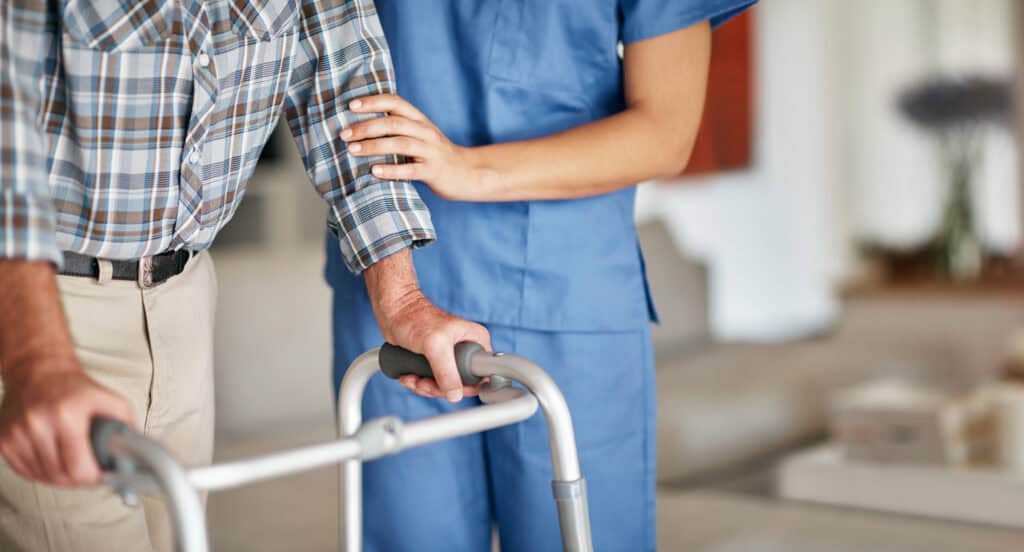Did you know that falls are the leading cause of injury-related death among adults aged 65 and older, and the fall death rate is increasing? According to the CDC, the age-adjusted fall death rate increased by 41% from 55.3 per 100,000 older adults in 2012 to 78.0 per 100,000 older adults in 2021. As we age, our bodies undergo a myriad of changes that can impact our physical abilities and increase our susceptibility to falls. The natural aging process often brings about a decline in muscle mass and strength, as well as a reduction in bone density, which can make seniors more vulnerable to falls. Additionally, changes in vision, balance, and coordination can affect how older adults navigate their surroundings and respond to potential hazards.
Falls among seniors can have serious consequences, ranging from minor injuries like bruises and cuts to more severe outcomes such as fractures, head trauma, and even death. Research indicates that falls are a leading cause of fatal injuries among older adults, highlighting the urgent need to address this issue and adopt preventive measures to safeguard seniors’ well-being.
The impact of falls on seniors extends beyond physical injuries, as the psychological effects can be significant as well. A fall can erode a senior’s confidence and independence, leading to fear of falling again and subsequent social isolation or reduced engagement in activities they once enjoyed. This loss of autonomy can have profound implications for their overall quality of life and mental health.
Given the gravity of the risks associated with falls for seniors, it is imperative to raise awareness about the dangers they pose and empower older adults, their families, and caregivers with knowledge and strategies to prevent falls. By understanding the factors that contribute to falls and implementing proactive measures to mitigate these risks, we can create safer environments and support systems for seniors to thrive and age gracefully.
In the following sections of this blog post, we will delve deeper into the topic of preventing falls for seniors by addressing the common causes of falls among seniors, explore the importance of home safety modifications, discuss the role of exercise and physical health in fall prevention, highlight the benefits of assistive devices, and emphasize the significance of awareness and education in reducing falls among older adults. By equipping ourselves with these insights and tools, we can work together to safeguard our aging population and ensure their safety and well-being.
Understanding the Dangers of Falls for Seniors:
- According to the World Health Organization, falls are the second leading cause of accidental or unintentional injury deaths worldwide.
- Seniors are more susceptible to falls due to factors such as diminished vision, decreased balance, and reduced muscle strength.
- Falls can lead to severe consequences, including fractures, head injuries, and a loss of independence among seniors.
Common Causes of Falls for Seniors:
- Environmental hazards: uneven flooring, inadequate lighting, loose rugs, and cluttered walkways.
- Medications and health conditions: side effects of certain medications and conditions like arthritis, low blood pressure, and neurological disorders can increase the risk of falls.
- Muscle weakness and balance issues: age-related muscle loss and a decline in balance can make seniors more prone to falls.
Preventing Falls- Best Practices for Senior Safety:
Home Safety Measures:
- Remove tripping hazards: ensure clear walkways, remove loose rugs, and secure electrical cords out of the way.
- Adequate lighting: install proper lighting to illuminate indoor and outdoor areas, especially staircases and hallways.
- Grab bars and handrails: install grab bars in bathrooms and handrails on staircases to provide support.
- Non-slip surfaces: use non-slip mats in the bathroom and secure rugs with non-slip backing throughout the house.
Exercise and Physical Health:
- Regular exercise: engage in physical activities that improve strength, balance, and flexibility, such as tai chi, yoga, or walking.
- Vision and hearing check-ups: regular visits to eye and ear specialists can identify and address impairments that increase the risk of falls.
- Medication review: consult with healthcare professionals to assess side effects and interactions of medications that may contribute to falls.
Assistive Devices:
- Canes and walkers: utilize appropriate mobility aids to provide support while walking.
- Footwear: wear sturdy, well-fitted shoes with non-slip soles to provide stability.
- Fall detection and response systems: These systems typically involve wearable devices, such as pendants or wristbands, that use advanced sensors to detect falls. Upon detection, they automatically trigger an alert to a monitoring center, where trained professionals evaluate the situation and can dispatch help if necessary. These fall detection and response systems provide an added layer of safety and peace of mind for older adults and their caregivers.
Awareness and Education:
- Fall prevention programs: seniors and caregivers can benefit from community-based programs that educate about fall risks and prevention strategies.
- Regular check-ins: frequent communication and support from family members, friends, or caregivers can help identify potential hazards and concerns.
Inspired Living is Proactive about Fall Prevention
Inspired Living is committed to prioritizing fall prevention and ensuring the safety of its residents. Through a comprehensive approach to resident wellness, including personalized care plans and ongoing assessments, Inspired Living focuses on addressing individual needs and reducing fall risks. The community provides a supportive environment that promotes physical activity, offers exercise programs tailored to improve strength and balance, and conducts regular vision and hearing screenings to detect any impairments that may contribute to falls. Additionally, Inspired Living incorporates innovative technology and safety features within its facilities, such as handrails, non-slip surfaces, and emergency response systems, to mitigate fall risks and provide quick assistance in case of an incident.
By proactively addressing fall prevention strategies and creating a culture of safety, Inspired Living instills confidence and peace of mind among its residents and their families. Through a combination of education, environmental modifications, physical wellness initiatives, and technological advancements, Inspired Living demonstrates its unwavering commitment to promoting the well-being and independence of seniors. Together, as a community and industry leader in senior care, we can continue to prioritize fall prevention efforts, safeguard the health and safety of our aging population, and enhance their overall quality of life. Schedule a tour today to experience the Inspired Living Difference.




